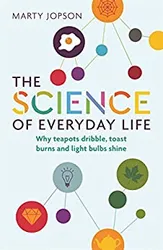This book is a collection of topics on the subject of everyday phenomena, with descriptions of the science behind these phenomena. For example, the author describes how batteries work (and what happens if you try to recharge a non-rechargeable alkaline battery), and why fresh air might be good for you.
There are lots of good illustrations and diagrams throughout the book to help with the explanations. The author brings a lot of their personality to the book by expressing their preference for crunchy apples or describing their attempt at the Slinky world record. It’s a really fun book to read and it made me look at the objects around me in a new way, wondering about why things work the way they do. I really enjoyed the sense this book gave me of peeling back the surface of familiar objects and looking at the details of how they really work. I’m also really keen to go and try throwing a boomerang after reading the chapter on how they work!
Despite its fun and irreverent tone, there’s really interesting science in this book. Some of the phenomena are well understood and really well explained, such as the chapters that talk about transparency to light: raw egg whites, and why they become opaque to light when cooked, glass and the greenhouse effect, and the leaves on trees absorbing only certain wavelengths of light. The book also discusses everyday phenomena that don’t have a clear scientific explanation, or for which there are several competing plausible explanations where scientists don’t agree on which is correct. For example, why our fingers go wrinkly when we put them in water. There is a theory based on it giving us extra grip in wet conditions which is very plausible, but this kind of thing is very hard to prove. It’s interesting to think about though. It shows that you don’t necessarily need access to a particle accelerator to further our understanding of the universe; you could start in your kitchen or bathtub.
The book covers a wide range of topics and I don’t think there was a single topic that I wasn’t interested in reading about. The chapters are short and succint. There are a couple of suggestions for futher reading. I’m interested to read Michael Faraday’s The Chemical History of a Candle for a future review, for example. It might have been nice to have a few more follow up suggestions, or a list of references at the end of the book. But generally each chapter left me satisfied and I think I learned something new in just about every one. I didn’t know about the different types of smoke alarm, for example, or how those motion detectors used in alarm systems work.
I think anyone who has an interest in the world around them, and is constantly asking questions about how things work, will get a lot out of this book.
